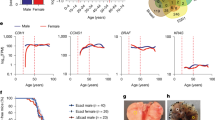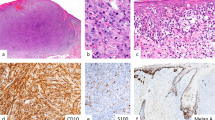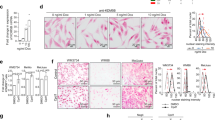Summary
Epidemiological studies show female survival benefit in advanced metastatic melanoma. In investigating a possible mechanism for this female survival benefit, we have previously reported that the female steroid 17β-oestradiol significantly reduces invasion of a human melanoma cell line (A375-SM cells) and ocular melanoma cells through fibronectin. Neither cell type was found to possess oestrogen receptor-α. The aim of the current study was to obtain further information on the extent to which progression of cutaneous melanoma might be sex steroid sensitive by (a) examining the relationship between circulating sex steroids, sex hormone binding globulin and disease progression; (b) examining the relationship between sex steroid structure and the ability of steroids to reduce invasion of a melanoma cell line in vitro; and (c) examining the effects of sex steroids on proliferation of these cells in vitro. We report a significant reduction in circulating oestrone with disease progression in male but not female patients. Examining steroids for their ability to inhibit invasion of A375-SM cells through fibronectin in vitro, oestrogenic compounds (17β-oestradiol and oestrone) were found to inhibit invasion; in this respect, oestrone was approximately 50 times more potent than 17β-oestradiol; steroids lacking the benzene ring structure did not inhibit invasion, indeed dehydroepiandrosterone (DHEA) which acts as a precursor to androgenic steroids significantly enhanced invasion. Proliferation of A375-SM cells was unaffected by 17β-oestradiol, oestrone or dihydrotestosterone when cells were cultured on plastic; in contrast, all three steroids induced modest proliferation of cells when grown on fibronectin with dihydrotestosterone the most mitogenic of the three steroids. These data are consistent with sex steroids playing a role in melanoma progression.
Similar content being viewed by others
Article PDF
Change history
16 November 2011
This paper was modified 12 months after initial publication to switch to Creative Commons licence terms, as noted at publication
References
Brandenberger, A. W., Tee, M. K., Lee, J. Y., Caho, V. & Jaffe, R. B. (1997). Tissue distribution of oestrogen receptors alpha and beta mRNA in the midgestational human foetus. J Endocrinol Metab 82: 3509–3512.
Breslow, A. (1970). Thickness, cross-sectional areas and depth of invasion in the prognosis of cutaneous melanoma. Ann Surg 172: 902–908.
Cocconi, G., Bella, M., Calabresi, F., Tonato, M., Canaletti, Boni, C., Buzzi, F., Ceci, G., Corgna, E., Costa, P., Lottici, R., Papadia, F., Sorfa, M. C. & Bacchi, M. (1992). Treatment of metastatic malignant melanoma with dacarbazine plus tamoxifen. N Engl J Med 327: 516–523.
Cuzick, J., Allen, M., Baum, J., Barrett, J., Clark, G., Kakkar, V., Melissari, E., Moniz, C., Moore, J., Parsons, V., Pemberton, K., Pitt, P., Richmond, W., Houghton, J. & Riley, D. (1993). Long-term effects of tamoxifen. Eur J Cancer 29A: 15–21.
Daffada, A. A. I., Johnston, S. R. D., Smith, I. E., Detre, S., King, N. & Dowsett, M. (1995). Exon 5 deletion variant estrogen receptor messenger mRNA expression in relation to tamoxifen resistance and progesterone receptor/pS2 status in human breast cancer. Anticancer Res 55: 288–293.
De Ryck, L., Ross, J. B. A., Petra, P. H. & Gurpide, E. (1985). Oestradiol entry into endometrial cells in suspension. J Steroid Biochem 23: 145–152.
Dewhurst, L. O., Gee, J. W., Rennie, I. G. & Mac Neil, S. (1997). Tamoxifen, 17β oestradiol and the calmodulin antagonist J8 inhibit human melanoma cell invasion through fibronectin. Br J Cancer 75: 860–868.
Duncan, L. M., Travers, R. L., Koerner, F. C., Mihm, M. C. & Sober, A. J. (1994). Estrogen and progesterone receptor analysis in pregnancy associated melanoma: absence of immunohistochemically detectable hormone receptors. Hum Pathol 25: 36–41.
Edwards, M., Grant, A. W. & MacKie, R. M. (1992). Human melanoma cell-derived factor(s) stimulates fibroblast glycosaminoglycan synthesis. Int J Cancer 52: 499–503.
Feucht, K. A., Walker, M. J., Das Gupta, T. K. & Beattie, C. W. (1988). Effect of 17β oestradiol on the growth of estrogen receptor positive human melanoma in vitro and in athymic mice. Cancer Res 48: 7093–7101.
Gefeller, O., Hassan, K. & Wille, L. (1998). Cutaneous malignant melanoma in women and the role of oral contraceptives. Br J Dermatol 138: 122–124.
Jordon, V. C., Fritz, N. F. & Tormey, D. C. (1987). Long-term adjuvant therapy with tamoxifen: effects on sex hormone binding globulin and antithrombin III. Cancer Res 47: 4517–4519.
Karjalainen, S. & Hakulinen, T. (1988). Survival and prognostic factors of patients with skin melanoma: a regression model analysis based on Nationwide Cancer Registry data. Cancer 62: 2274–2280.
Ladanyi, A., Timar, J., Bocsi, J., Tovari, J. & Lapis, K. (1995). Sex-dependent liver metastasis of human melanoma lines in SCID mice. Melanoma Res 5: 83–86.
Luqmani, Y. A., Smith, J. & Coombes, R. C. (1992). Polymerase chain reaction-aided analysis of gene expression in frozen tissue sections. Ann Biochem 200: 291–295.
MacKie, R. M., Bufalino, R., Morabito, A., Sutherland, C. & Cascinelli, N. (1991). Lack of effect of pregnancy on outcome of melanoma. Lancet 337: 633–635.
Mac Neil, S., Wagner, M., Kirkham, P. R., Blanksom, E. A., Lennard, M. S., Goodall, T. & Rennie, I. G. (1993). Inhibition of melanoma cell/matrix interaction by tamoxifen. Melanoma Res 3: 67–74.
Miller, J. G., Gee, J., Price, A., Wagner, M. & Mac Neil, S. (1997). Investigation of oestrogen receptors, sex steroids and soluble adhesion molecules in the progression of malignant melanoma. Melanoma Res 7: 197–208.
Miller, J. G. & Mac Neil, S. (1997). Gender and cutaneous melanoma. Br J Dermatol 136: 657–665.
Morvillo, V., Luthy, I. A., Bravo, A. I., Capurro, M. I., Donaldson, M., Quintans, C., Calandra, R. S. & Mordah, J. (1995). Atypical androgen receptor in the human cutaneous melanoma cell line 11B-Mel-J. Pigment Cell Res 8: 135–141.
O’Brian, J. P., Frye, R. A., Cogswell, P. C., Neubauer, A., Kitch, B., Prokop, C., Espinosa, R., Le Beau, M. M., Earp, H. S. & Liu, E. T. (1991). Axl, a transforming gene isolated from primary human myloid leukemia cells, encodes a novel receptor tyrosine kinase. Mol Cell Biol 11: 5016–5031.
Petra, P. H. (1991). The plasma sex steroid binding protein. A critical review of recent developments on the structure, molecular biology and function. J Steroid Biochem Mol Biol 40: 75–753.
Rosner, W., Hryb, D., Khan, S., Nakhla, A. M. & Romas, N. (1991). Sex hormone binding globulin: anatomy and physiology of a new regulatory system. J Steroid Biochem Mol Biol 40: 813–820.
Shaw, H. M., McGovern, J., Milton, G. W., Farago, G. & McCarthy, W. H. (1980). Malignant melanoma: influence of site of lesion and age of patient in the female superiority in survival. Cancer 46: 2731–2735.
Shaw, H. M., Milton, G. W., Farago, G. & McCarthy, W. H. (1978). Endocrine influences on survival from malignant melanoma. Cancer 42: 669–677.
Slingluff, C. L. & Seigler, H. F. (1992). Malignant melanoma and pregnancy. Ann Plast Surg 28: 95–99.
Stidham, K. R., Johnson, J. L. & Seigler, H. F. (1994). Survival superiority of females with melanoma: a multivariate analysis of 6383 patients exploring the significance of gender in prognostic outcome. Arch Surg 129: 316–324.
Travers, R. L., Sober, A. J., Berwick, M., Mihm, Jr, M. C., Barnhill, R. L. & Duncan, L. M. (1995). Increased thickness of pregnancy-associated melanoma. Br J Dermatol 132: 876–883.
Vladusic, E. A., Hornby, A. E., Guerra-Vladusic, F. K. & Lupu, R. (1998). Expression of estrogen receptor ss messenger in breast cancer. Cancer Res 58: 210–214.
Wheeler, M. J., De Souza, A., Matadeen, J. & Croos, P. (1996). Ciba Corning ACS:180 testosterone assay evaluated. Clin Chem 42: 1445–1449.
Wians, F. H. & Stuart, J. (1997). Ciba Corning ACS:180 Direct total testosterone assay can be used on female sera. Clin Chem 43: 1466–1467.
Author information
Authors and Affiliations
Rights and permissions
From twelve months after its original publication, this work is licensed under the Creative Commons Attribution-NonCommercial-Share Alike 3.0 Unported License. To view a copy of this license, visit http://creativecommons.org/licenses/by-nc-sa/3.0/
About this article
Cite this article
Richardson, B., Price, A., Wagner, M. et al. Investigation of female survival benefit in metastatic melanoma. Br J Cancer 80, 2025–2033 (1999). https://doi.org/10.1038/sj.bjc.6690637
Received:
Revised:
Accepted:
Published:
Issue date:
DOI: https://doi.org/10.1038/sj.bjc.6690637
Keywords
This article is cited by
-
Melanoma survival is superior in females across all tumour stages but is influenced by age
Archives of Dermatological Research (2015)
-
Sex-dependent liver colonization of human melanoma in SCID mice—role of host defense mechanisms
Clinical & Experimental Metastasis (2013)
-
Gender Differences in Melanoma Survival: Female Patients Have a Decreased Risk of Metastasis
Journal of Investigative Dermatology (2011)
-
Malignant melanoma with gall bladder metastasis as a second neoplasm in the course of prostate cancer
Pathology & Oncology Research (2004)
-
Anti-inflammatory and anti-invasive effects of α-melanocyte-stimulating hormone in human melanoma cells
British Journal of Cancer (2003)



